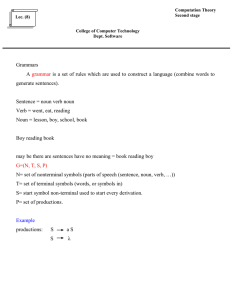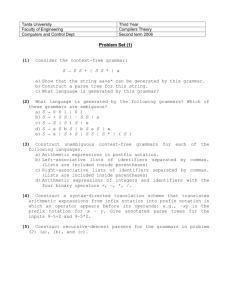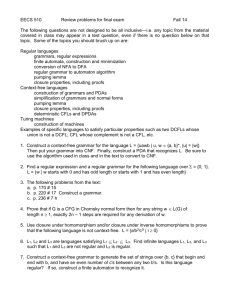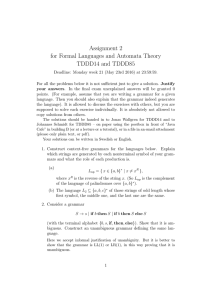Outline for today • Grammars • First-order logic
advertisement
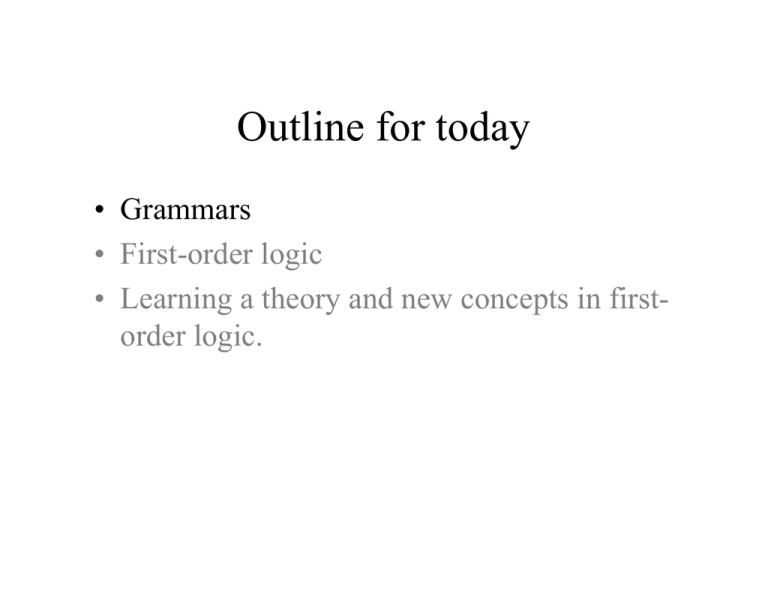
Outline for today • Grammars • First-order logic • Learning a theory and new concepts in firstorder logic. Finite-state grammar • The “minimal linguistic theory”. lucky tired s2 s0 the a boy girl saw tasted treats defeat s1 s3 s4 s5 Figure by MIT OCW. E.g., “The lucky boy tasted defeat.” Generating infinite strings lucky tired s2 s0 the a boy girl saw tasted treats defeat s1 s3 s4 s5 Figure by MIT OCW. E.g., “The lucky tired tired … boy tasted defeat.” Parses novel sequences lucky colorless green stupendous beige ... furiously mercilessly ... s2 s0 the a s1 boy girl ideas ... s3 saw tasted sleep circumnavigate ... s4 Figure by MIT OCW. E.g., “Colorless green ideas sleep furiously” treats defeat s5 What’s really wrong • The problem with the “statistical” models isn’t that they are statistical. • Nature of representation: – N-grams: Perceptual/motor/superficial/concrete • Utterance is a sequence of words. – Chomsky: Cognitive/conceptual/deep/abstract • Finite-state grammar: utterance is a sequence of states. • Phrase-structure grammar: utterance is a hierarchical structure of phrases. Counterexamples to sequential models • Center embedding – The man dies. – The man that the racoons bite dies. – The man that the racoons that the dog chases bite dies. – The man that the racoons that the dog that the horses kick chases bite dies. Generating embedded clauses lucky tired s2 s0 the a boy girl saw tasted treats defeat s1 s3 s4 s5 Figure by MIT OCW. E.g., “A lucky boy the tired girl saw tasted defeat.” No way to ensure subject-predicate agreement. Generating embedded clauses lucky tired s2 s0 the a boy girl saw tasted treats defeat s1 s3 s4 s5 Figure by MIT OCW. E.g., “A lucky boy the tired girl saw tasted defeat.” “A lucky boy the tired girl saw saw saw saw ... saw treats.” Counterexamples to sequential models • Tail-embedding – The horse that kicked the dog that chased the racoons that bit the man is alive. – The horses that kicked the dog that chased the racoons that bit the man are alive. • Fundamental problem: Dependencies may be arbitrarily long-range in the sequence of words. Only local in the phrase structure. Image removed due to copyright considerations. Please see: http://www.cs.umd.edu/class/fall2003/cmsc421-0101/chapter22-6pp.pdf _____________________________________________________________________________________ “Context-free” or “Phrase-structure” grammar: Image removed due to copyright considerations. Please see: http://www.cs.umd.edu/class/fall2003/cmsc421-0101/chapter22-6pp.pdf _____________________________________________________________________________________ Image removed due to copyright considerations. Please see: http://www.cs.umd.edu/class/fall2003/cmsc421-0101/chapter22-6pp.pdf _____________________________________________________________________________________ Image removed due to copyright considerations. Please see: http://www.cs.umd.edu/class/fall2003/cmsc421-0101/chapter22-6pp.pdf _____________________________________________________________________________________ Image removed due to copyright considerations. Please see: http://www.cs.umd.edu/class/fall2003/cmsc421-0101/chapter22-6pp.pdf _____________________________________________________________________________________ Image removed due to copyright considerations. Please see: http://www.cs.umd.edu/class/fall2003/cmsc421-0101/chapter22-6pp.pdf _____________________________________________________________________________________ Image removed due to copyright considerations. Please see: http://www.cs.umd.edu/class/fall2003/cmsc421-0101/chapter22-6pp.pdf _____________________________________________________________________________________ Context-free grammars for embedded clauses • For center embedding: S → NP VP NP → Det [ Adj ] Noun [ RelClause] RelClause → [ Rel ] NP V VP → VP NP VP → Verb Phrase structure S VP NP VP Det Adj Noun A lucky boy Verb NP Noun tasted defeat. Phrase structure S NP VP NP RelClause Det Adj Noun A lucky boy Verb NP Det Adj the tired VP Noun Verb girl saw NP Noun tasted defeat. Phrase structure S NP VP ... RelClause VP NP Det Adj the tired ? Noun Verb girl saw ? Verb NP Noun tasted defeat. saw What is special about this “structured” representation? • Generative: – “Infinite use of finite means” • Recursive. – E.g., for any sentence S, can say, “I think that S”, “Mary desires that S”, “Napoleaon’s Italian stepmother naively hoped that S”, …. • Generates structures of greatly varying complexity. • Abstract. – Principles formulated over abstract concepts (e.g., NP, VP), whose meaning is defined only within the system. • Multiple levels of abstraction…. Class of grammars Context-free grammar: • Terminals • Nonterminals • Rewrite rules: One terminal -> one or more terminals or nonterminals S → NP VP Grammar NP → Det [ Adj ] Noun [ RelClause] RelClause → [ Rel ] NP V VP → VP NP VP → Verb Phrase structure Image removed due to copyright considerations. Please see: http://www.cs.umd.edu/class/fall2003/cmsc421-0101/chapter22-6pp.pdf _________________________________________________________ Utterance Class of grammars Context-free grammar: • Terminals • Nonterminals • Rewrite rules: One terminal -> one or more terminals or nonterminals S → NP VP Grammar NP → Det [ Adj ] Noun [ RelClause] RelClause → [ Rel ] NP V VP → VP NP VP → Verb Phrase structure parsing Image removed due to copyright considerations. Please see: _________________________________________________________ http://www.cs.umd.edu/class/fall2003/cmsc421-0101/chapter22-6pp.pdf Utterance Class of grammars Context-free grammar: • Terminals • Nonterminals • Rewrite rules: One terminal -> one or more terminals or nonterminals S → NP VP Grammar NP → Det [ Adj ] Noun [ RelClause] RelClause → [ Rel ] NP V VP → VP NP VP → Verb grammar acquisition Phrase structure Image removed due to copyright considerations. Please see: http://www.cs.umd.edu/class/fall2003/cmsc421-0101/chapter22-6pp.pdf _________________________________________________________ Utterance SEQUITUR Induction of context-free grammars based on two principles of compression: 1. No digram (sequence of two symbols) should appear twice. 2. Every rule should be used at least twice. Image removed due to copyright considerations. Image removed due to copyright considerations. What about statistics? • Probabilities can be added to any of these structured grammars. – Probabilistic finite-state automaton: P(state i|state j), P(word i|state j) instead of P(word i|word j) – Probabilistic context-free grammar: P(rewrite rule i|non-terminal j) What about statistics? • Probabilities can be added to any of these structured grammars. – Probabilistic finite-state automaton – Probabilistic context-free grammar • Advantages: – Resolve ambiguities in parsing and translation. (e.g., Keller) – Integrate with speech recognition and visual perception. – Grammar induction as statistical learning. Class of grammars Context-free grammar: • Terminals • Nonterminals • Rewrite rules: One terminal -> one or more terminals or nonterminals S → NP VP Grammar NP → Det [ Adj ] Noun [ RelClause] RelClause → [ Rel ] NP V VP → VP NP VP → Verb ? Phrase structure Image removed due to copyright considerations. Please see: http://www.cs.umd.edu/class/fall2003/cmsc421-0101/chapter22-6pp.pdf _________________________________________________________ Utterance Lessons • Structure matters. – Can’t get to phrase structure with purely sequential representations, no matter how powerful your statistics. • Structure and statistics are complementary. – Statistics is about inference, structure is about representation. – Generative linguistics: negative example. – Modern computational linguistics: + example. • What’s special about a structured representation? – Generative, recursive, abstract Other applications for phrase structures and grammars? • Driving Start car Step on gas Move leg Push gas Turn on ignition Take out key Insert key in ignition Turn key Other applications for phrase structures and grammars? • Driving • Cooking Image removed due to copyright considerations. Please see: Forde, E. M. E., and G. W. Humphreys. "Category Specific Recognition Impairments: A Review of Important Case Studies and Influential Theories." Aphaisiology 13, no. 3 (1999): 169-193. Image removed due to copyright considerations. Please see: Cooper, R. P., and T. Shallice. "Contention Scheduling and the Control of Routine Activities." Cognitive Neuropsychology 17 (2000): 297-338. Other applications for phrase structures and grammars? • Driving • Cooking • Music and dance – Schenker – Bernstein – Lerdahl and Jackendoff Other applications for phrase structures and grammars? • Driving • Cooking • Music and dance – Schenker – Bernstein – Lerdahl and Jackendoff • Is any behavior not hierarchically organized? Is any behavior merely finite state? The architecture of human behavior (1950’s-1970’s) • Chomsky, Syntactic Structures • Newell and Simon: The General Problem Solver • Miller, Galanter, and Pribram, Plans and the structure of behavior. • Production systems: Anderson, Newell – If GOAL and CONDITIONS then ACTION Outline for today • Grammars • First-order logic • Learning a theory and new concepts in firstorder logic. Why not just spaces or features to represent concepts? • Euclidean space is fine for representing basic similarity relations between concepts, or values of concepts on a small number of fixed dimensions. • But what about more abstract “concepts about concepts”? – Point x is on the line between y and z. – The relation between a and b is a good analogy for the relation between c and d. – The point x is the nearest neighbor of y. First-order logic • A language for talking about things, their properties and their relations. – Specific facts about particular objects – General laws about kinds of objects and their relations. • In other words, a language for expressing theories of the world. First-order logic • Basic ingredients: Image removed due to copyright considerations. Please see: http://www.cs.umd.edu/class/fall2003/cmsc421-0101/chapter22-6pp.pdf ______________________________________________________________________________________ The grammar of first-order logic Image removed due to copyright considerations. Please see: http://www.cs.umd.edu/class/fall2003/cmsc421-0101/chapter22-6pp.pdf ______________________________________________________________________________________ First-order logic in cognition • May be skeptical, because people have a hard time reasoning logically. – If A then B, A, therefore B. OK. – If A then B, not-B, therefore not A. Huh? • What about probabilities and graded inferences? • The importance of logic is in expressive representation, not necessarily deductive inference. First-order logic in cognition • Natural language semantics – “Somebody’s gonna hurt someone before the night is through.” – “Everybody wants to touch somebody if it takes all night.” This is subtle…. ∃y ∀x ( wants ( x, touch( x, y )) ∀x ∃y ( wants ( x, touch( x, y )) ∀x ( wants ( x, ∃y touch( x, y ))
